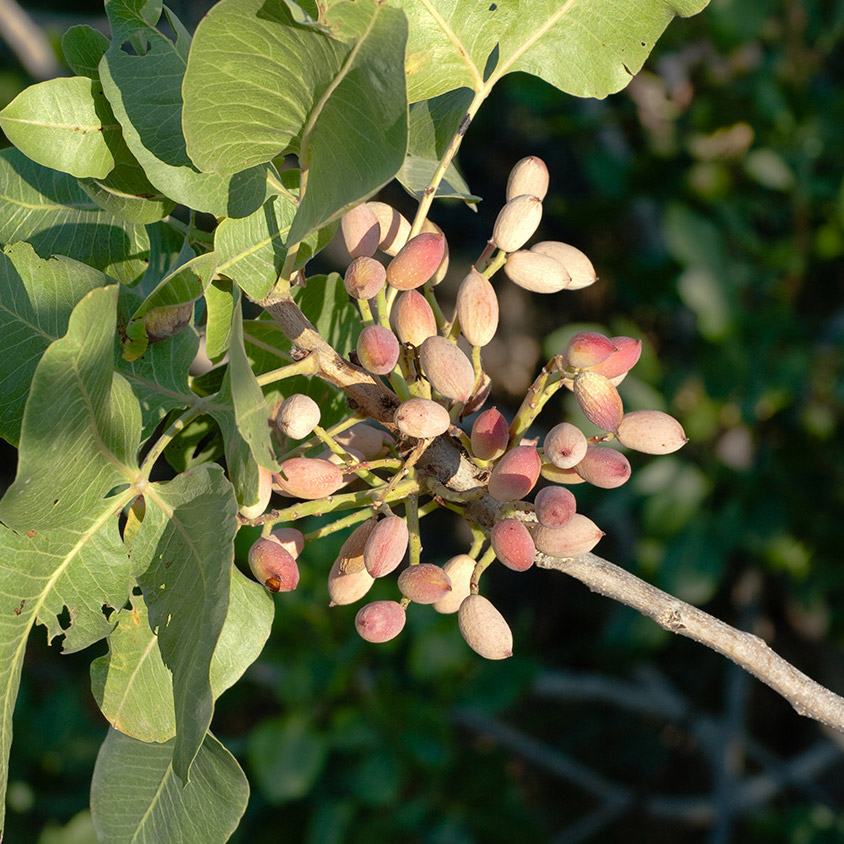Pistacia vera is a non-hermaphrodite plant of Persian origin, with a short stem not dissimilar in its aspect to the fig. Pistachio is a long-lived plant (from 200 to 300 years old). It has a very slow development, and it is able to produce only after almost ten years from its grafting. It has peculiar characteristics which distinguish it from other tree species of agrarian interest or from the same pistachio cultivated in other Sicilian areas (Caltanissetta or Agrigento) or abroad (Middle East, Greece or California and Argentina).
The plant, resinous, with a thick and wide foliage with pendent clusters of fruits, does not exceed the height of 5 meters. It has deep roots, a short trunk and twisted branches, a yellow-reddish bark that turns gray when the plant is adult, and leathery, deciduous leaves.
Pistachio produces fruits, drupes, with a pearl-colored leathery skin, containing characteristic seeds with a purplish red pericardium and emerald green kernel.
The fruit is presented in clusters like the ones of cherries, but with a much higher number of nuts, with a rubbery and resinous white-reddish colored shell which, at the moment of maturity, wraps a very resistant woody shell.
The pistachio groves (for the people of Bronte, the “lochi“) are mainly cultivated on almost 4,000 hectares of lava soil, with a very limited arable layer, mixed with even rocky sites, of little agronomic value, with steep and uneven slopes and not easily accessible.
On this type of land grows spontaneously and is able to adapt a tree species, the terebinth (“pistacia terebinthus“), a plant with great rusticity and resistance to drought. In Bronte it is called “scornabecco” or also “spaccasassi” and it is worth remembering that it derives from the Spanish cornicabra (goat horn), with the same meaning.
With a very deep root system, it is able to make its way through the cracks in the lava rock, growing easily even on loose soil that is difficult to cultivate.
The terebinth is used by Brontese farmers, since ancient times, as rootstock of the pistachio plant (“pistacia vera”).
It is rightly considered as the one which provides the best production, resistant to drought and with which it is possible to obtain plants which produce a lower number of empty fruits.

An arboreal transformation that must be considered the result of the work of generations, implemented with patience and techniques handed down from father to son, forced to cultivate lava in order to survive.
Deprived of fertile lands – most of which were owned by the Ducea and a few others – the Brontese farmer in almost two centuries of laborious work, managed with this technique to transform many lava flows into areas cultivated with pistachios, producing high quality fruits, immediately appreciated in European markets. The plant found the ideal climate, the predominant one of the Etna area, altitude of about 400-700 meters above sea level, average spring temperatures of about 12° and, for the ripening, about 27° in July-August, with some stormy rains which favored the full development of the fruit.
Unfortunately, the typology of lava soil has always prevented the introduction of any kind of mechanization and therefore it did not allow the reduction of high production costs.
Still today, the only machines used in some farms are brush cutters, tiller, and some low-powered motor pumps.
For the rest, the work of the farmer always prevails, the work of the hoe, rakes, scythe, and pump for shoulder spraying.



